I thought I would share my process when it comes to creating a layout. It's so interesting to me to see how other scrapbookers do things, so I thought someone might find this interesting, too.
Step 1: Start with photos and a storySometimes I have a story I want to scrap and I will go look for photos to go with the story. Other times I have some photos I want to scrap and will decide which story I want to tell with them.
I specifically took the photo on this layout so I could scrap the story of the tests I was going through at the time. Thankfully, my husband doesn't even hesitate when I ask him to take photos of things like wires coming out of my shirt!
Step 2: Select papers that go with the photos/story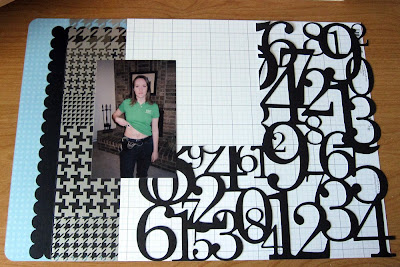
Notice I didn't say I pick papers that
match the photo. Rather, I pull out papers that complement the photo and convey the overall feeling that I want the layout to have. Typically, I pull papers for 3-4 layouts at a time to maximize efficiency.
In this photo I'm wearing a green work polo, but there's no green anywhere in the papers. Instead, I chose cool colors with more angular and graphic patterns. The grid and number papers especially lend themselves to a layout about doctor's visits and medical tests.
Step 3: Choose coordinating embellishments 
After I have a good selection of papers, I pick out title options (stickers, rubons or stamps) and embellishments that coordinate with the papers and continue to contribute to the feeling I want to convey. I may or may not actually have an idea of how I want to use these items. It doesn't matter, since the point is only to narrow my options so that I don't get sidetracked shuffling through my stuff over and over again while I'm creating my layout.
Here I pulled out title options that were black and white, a black rick rack trim (kind of like an EKG?) , silver accents which evoke the cold metallic feel of a doctor's office, and a blue items to bring in the blue from the patterned paper. At this point I had no idea how I wanted to use any of them.
Step 4: Journaling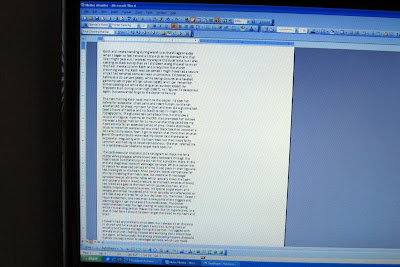
Figuring out my journaling at this point in the process is important so that I have enough room for it on the layout. Have you ever gotten to the end of making a layout and then realized that the amount of journaling you want to include is way more than you have space for? Yeah...um...me neither. Obviously, typed journaling takes up less space, so I prefer it when I need to journal a lot. I like handwritten journaling (especially on my cute journaling notebook pages or journaling spot stamps) for when I have less to say.
Once I wrote the story for this layout and picked a font I liked, I started playing with formatting. I reduced the margin to leave enough room for my photo along the side and then made minor adjustments to the margin and leading (the amount of space between the lines of text) until I was happy with how it looked.
Step 5: Testing the journaling
I use scrap paper to print out my journaling before I make the commitment to print it on cardstock or patterned paper. I'll lay my photos out on it to make sure they fit, make more adjustments if needed and then print another test page to be sure it's right. (You know I'm a little OCD by now, right?) When I handwrite my journaling I almost always write it out on scratch paper first so I can see how much space it will take up. When I'm using a journaling stamp it's even better--I just stamp it on scrap paper and rewrite until it looks good.
By this point I'd chosen "Vasovagal Syncope" as my title, and the length helped me decide on the small KI Memories alpha rubons. I made sure I had enough room at the top for two rows of title letters (and a common margin on all sides of the journaling/title block).
Step 6: Assembling the layout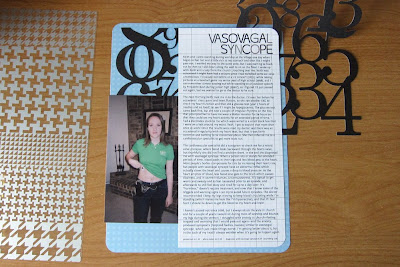
Once the journaling is printed (or prewritten, in the case of handwritten journaling) I start to move things around on the page until I'm happy. Often, I'm inspired by how papers looked when I laid them all out in Step 2. This step is also where I pay attention to design principles like balance, contrast and visual weight. I'm a frugal decision-impaired perfectionistic scrapper (which means this step probably take me longer than it does almost anyone else), so I don't cut anything until I'm absolutely sure it's what I'm going with.
With the journaling/title block completed you would think finishing the other 2/5ths of the layout would be quick, right? Not so much for me. Even after I decided where I wanted the KI Memories black number lace paper, I moved it around until I found just the right piece of it to show (See how the left side shows the curves of the numbers instead of a straight cut? It helps to break up all the straight lines in the layout.) I wanted to use the silver Hambly overlay at the bottom, but it didn't look right with the blue background showing through. I decided to put it over black cardstock (see also, how it appeared in Step 2), which also balanced out the black on the layout and gave the bottom of the page some visual weight.
Step 7: Take a step back
At this point the layout isn't missing anything important (story? check. photo? check. title? check. pretty papers? check). I can either stop here or take it to the next level.
I liked this layout so far, but it felt like it was missing something. It needed a little bit of texture. It also had what looked like four separate "compartments," so I wanted to add something that would overlap two to help break up all of the lines.
Step 8: Add details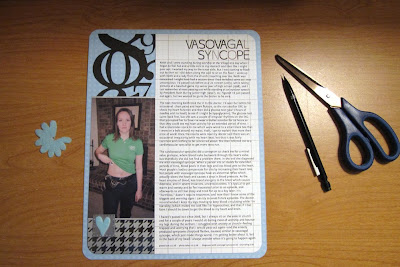
I typically keep my my embellishments simple. In addition to adding interest to my pages, I like to use them to further the design of the page. Here is where I like to incorporate concepts like repetition and the rule of threes.
Here a silver Making Memories stitched tin and a blue felt heart (cut from an American Crafts felt flower) repeat the blue and silver already appearing on the layout. I placed it so that it overlapped two areas of the page to help break up all of the horizontal lines. While it doesn't always work out this way, on this page the accent also represents the theme of the page--a soft, felt heart (my vasovagal syncope deals in part with my heart) on a cold metal square. You might also notice I added two very thin strips of silver cardstock framing out the photo.
Step 9: Final changes
Before I make the commitment to adhere things down, I look over the page to see if I'm happy. Sometimes I'll try out a different option to see if I like it better. This is where I usually stand on my chair and look down at the layout on my desk. It helps me to get a different perspective. I've heard of other scrappers taking a digital photo of their work in progress or looking at it in a mirror to achieve the same effect. I'm sure Keith wishes I did that instead; he's always warning me to be careful.
I felt like the original heart and metal square were too large, so I created a smaller version (made me glad I have the stitched tins and felt flowers in multiple sizes!) and tested it out. Perfect! At this size it doesn't draw away attention from the photo and journaling.
Step 10: Admire my work
Once everything is adhered, the layout is finally complete! I do my best not to second guess any design decisions (or find a type-o), because I draw the line at redoing a layout.
Thankfully, I'm completely satisfied with this layout! I won't read the journaling again, lest I discover a mistake (I'll let my Mom do that for me when she looks at the album. And you wonder where I get it.)
Step 11: Housekeeping
You thought we were done? Almost. Once a layout is complete I flip it over and record the important details: a supply list in the bottom left hand corner and the date completed and my signature in the bottom right hand corner. I actually started including a supply list long before I even thought about submitting (overachiever, remember?), but now that I do submit my work for publication it comes in very handy. I also scan my pages so I can post them online and submit them, but wait until I have a few layouts to hook up the scanner.
Yes, that's the back of my layout. It's actually the main design (kind of like an "a side") to a double-sided KI Memories patterned cardstock. I love the subtle prints they have on the back of their papers--I use those just as often as the front of the papers.
Step 12: Clean up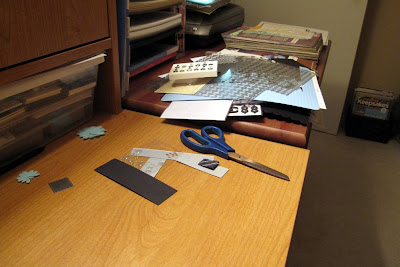
I clean up my desk after every layout. It's our computer desk, too, so chances are I'm going to need a clear surface to pay bills or cut coupons. Even if I'm going to start right in on another layout I clean things up, though, because I like to have things in order.
You can see here my stack of supplies that were set to the side as I either rejected them or finished using them. This is about as disheveled as my desk gets. Notice that there are things in the stack, like the Making Memories epoxy brads, that weren't pulled out in Step 3. I must have thought I was going to use them at some point. Just because I pull my supplies out at the beginning of my process doesn't mean that I refuse to allow myself to pull something else out later. I just don't spend time rifling through everything again.

That's my process! It involves a lot of moving things around and tweaking things, but I learned from experience that if I just "get it done" I'm usually not happy with the result. I scrap for the enjoyment of it and to share my stories and photos. Since I'm not obsessed with "catching up," it doesn't bother me that it takes me a little longer to complete a layout.
Here's a challenge for you: the next time you sit down to create layout, card, or other project, take some photos along the way. Post the photos on a blog or in a gallery along with a description of your "steps." Not only will it be interesting for others to see (send me a link if you do this, I'd love to see it.), but you may also learn a little more about your own creative process that will help you create more effectively in the future.
















